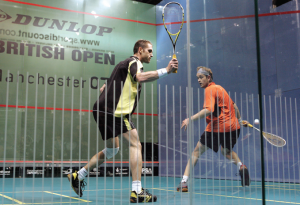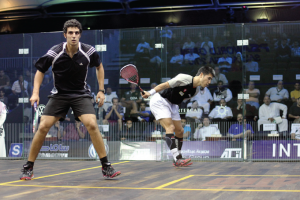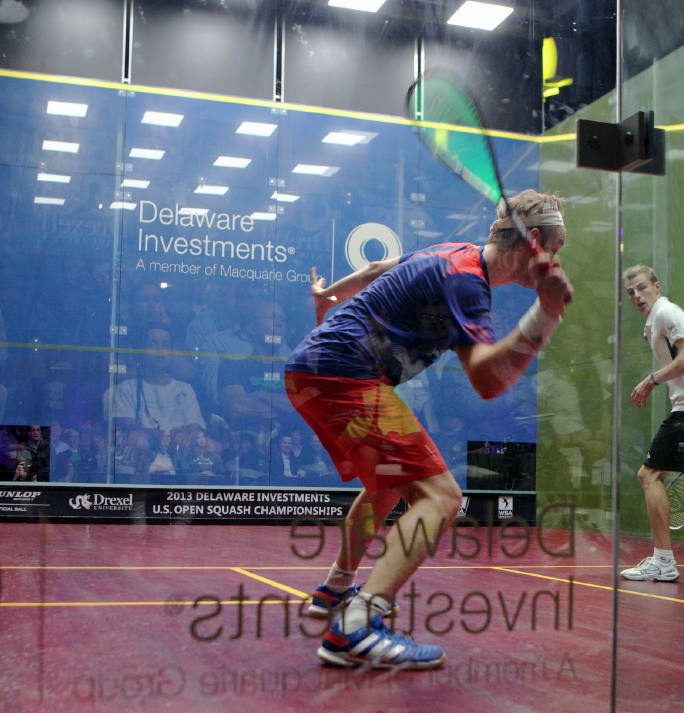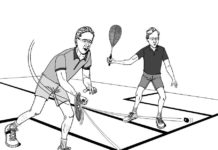By Barry Faguy, WSF Referees and Rules Committee
We now begin a short series of short articles dealing with what can be called ‘conventions’—used here in the sense of ‘understandings’ where we don’t necessarily follow the letter of the law. Once again, and particularly for this series, I’ll add my disclaimer about this not being official WSF interpretation. Nonetheless, I suspect that you’ll wind up recognizing the truth of these descriptions.
Paradoxically, the point of describing decision-making that is in apparent contradiction to the rules is to help make your officiating better— the idea being to heighten your general awareness of the rules and of real play. Remember that when something is broken (like an appeal stopping play), fixing it (rendering a fair decision) is easier when you know the nitty-gritty of how it works. So, with that in mind, let’s go to the first convention.
The “3/4-Front Wall Convention”
Some of you may immediately recognize what we’re getting at with that colloquial title. The rules are clear that, if the striker had not first turned or was not making a further attempt, and has hit or would have hit the non-striker with the ball that was traveling to any part of the front wall— it is a Stroke. In other words, a Stroke is awarded when the non-striker is found in the so-called ‘Danger Zone’ (the triangle formed by the ball and front-wall corners).

And sure enough, we do indeed award strokes in these situations:
Where the ball reached the striker by coming directly from the front wall (no walls involved)—and the striker then actually hit the non-striker with the ball;
Where the ball again reached the striker by coming directly from the front wall (no walls involved)—but the striker then refrained from hitting the non-striker with the ball; and
Where the ball reached the striker indirectly by first hitting a side wall and then the back wall—and the striker then actually hit the non-striker with the ball.
In all those cases, we tend to visualize the Danger Zone and the projected path of the ball with mathematical precision.
Here’s the convention
But—given the same side-wall/back- wall preamble described in the last bullet above—if the striker refrained from hitting the ball, we’ll rarely see a stroke awarded. This happens even if the non-striker is clearly in the Danger Zone, even blocking up to ¼ of the front wall—often much more. You can check out countless online videos of pro-matches, and you’ll be hard-pressed indeed to find a ‘Stroke’ decision with these very common scenarios.
In fact, most of the time when the situation occurs, the striker doesn’t bother stopping play and instead simply hits a boast or a straight drive to whatever part of the front wall is available—forgoing the opportunity for a stroke. You probably do this yourself when you play. The convention demands less of the non-striker than does the rule—apparently allowing a 25% (often much more) discount on that obligation to clear the front wall.
What’s going on?
What is it about the ball reaching the striker via the side and then back wall that makes things different? Let’s consider a few of reasons why strokes are not generally expected.
Firstly, many players, even the pros, live with the misconception that it can’t be a stroke if the ball has first hit the back wall.
Then, given the frequency of these scenarios, everyone realizes that they must necessarily ‘put some water in their wine’ to avoid constant stoppages in search of strokes—or to avoid potentially painful retribution in the event they actually hit their opponent.
Uncertainty precludes the stroke—and you might have multiple doubts, such as:
The striker’s ability to actually bring the ball in for a straight drive as it travels from side to often very close to the back wall, and dropping fast.
 The timing, where the exact moment of the intended appeal is unknown—mostly because there is rarely a verbal appeal.
The timing, where the exact moment of the intended appeal is unknown—mostly because there is rarely a verbal appeal.
The non-striker at that point, has often stopped clearing—but the ball continues its mostly lateral movement to behind him or her—making it look worse.
There’s a tendency to use the striker’s body position (rather than the ball) as the apex of your danger zone visualization. What to do?
Having said all that, the rules can’t just be ignored. If you fail to set a standard for clear cases, you’ll have players encroaching more and more into the danger zone with impunity—essentially resulting in unfair play. There’s a fine line that you will need to learn to tread. Here’s a few tips:
When in doubt (and, as we said, there can be plenty of that)—award a let.
Expand your field of vision to include everyone’s position—the whole picture.
Note the ball’s height and closeness to the back wall at the moment it would be hit.
Consider the players’ skill levels, and so the likelihood of their being able to bring the ball in for a straight drive—or just hit a boast.
In the absence of an audible appeal, use the moment that you determined play to have stopped—not a moment or two later when things can look very different.
Finally, and unfortunately, determining the opponent’s actual clearing effort, normally a very useful decision-making tool, is useless here. Either the opponent is in the way, or not.
With time, you’ll develop a subtle sensitivity for how certain players want to deal with such situations. As the Monty Python skit said: Know what I mean—know what I mean!





